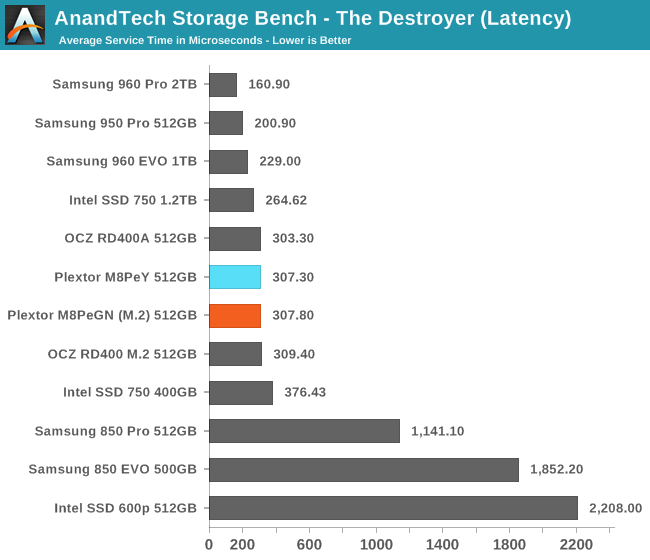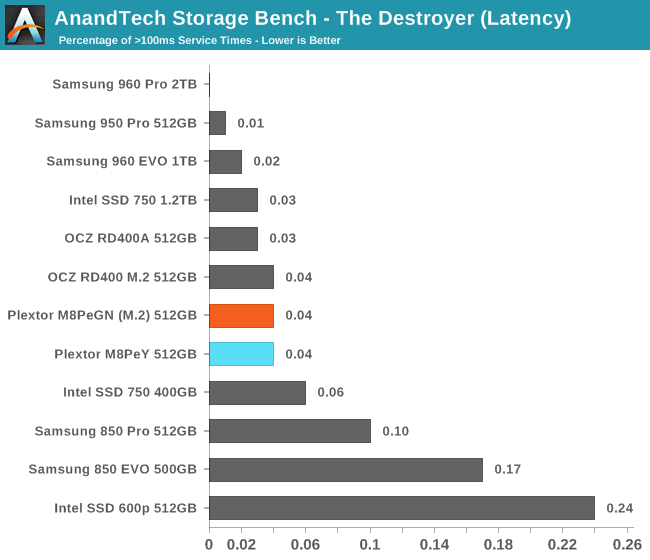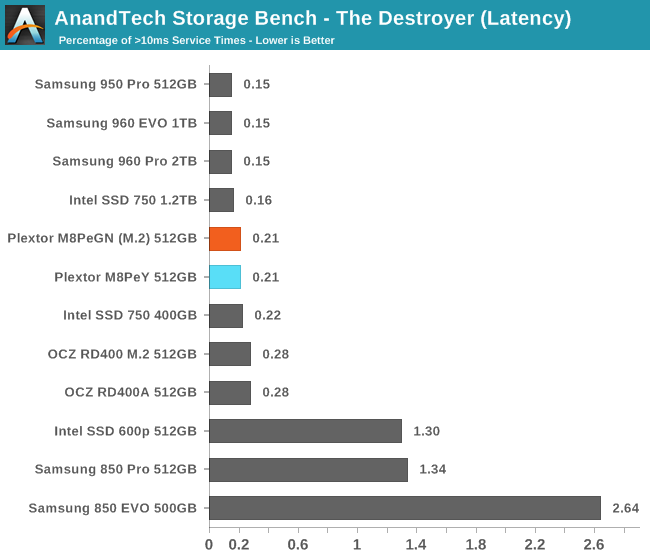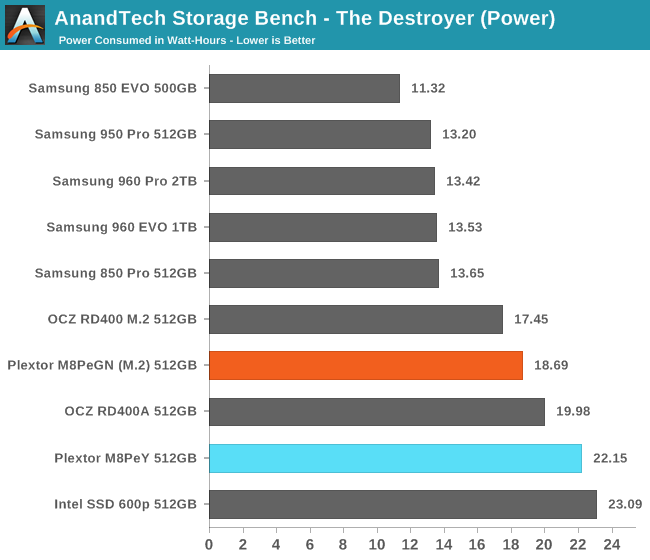The Plextor M8Pe (512GB) SSD Review
by Billy Tallis on December 14, 2016 9:00 AM ESTAnandTech Storage Bench - The Destroyer
The Destroyer is an extremely long test replicating the access patterns of very IO-intensive desktop usage. A detailed breakdown can be found in this article. Like real-world usage and unlike our Iometer tests, the drives do get the occasional break that allows for some background garbage collection and flushing caches, but those idle times are limited to 25ms so that it doesn't take all week to run the test.
We quantify performance on this test by reporting the drive's average data throughput, a few data points about its latency, and the total energy used by the drive over the course of the test.

The Plextor M8Pe isn't breaking any records on The Destroyer. Its average data rate is slower than Samsung's PCIe SSDs and the OCZ RD400, but it does beat the Intel SSD 750 and is about 75% faster overall than the fastest SATA SSDs. The heatsink on the M8PeY only provides a very slight performance boost.

The average service times of the M8Pe are on par with the OCZ RD400 and the Intel SSD 750, and substantially worse than Samsung's PCIe SSDs. The differences are minor in comparison to the huge latency advantage they all enjoy over the best SATA SSDs (and Intel's TLC-based SSD 600p).


The frequency of high-latency outliers places the M8Pe in the second tier of drives. Samsung's PCIe SSDs have few or no operations take more than 100ms and the smallest percentage of operations that exceed 10ms. The M8Pe scores similarly to the Intel SSD 750 and OCZ RD400.

The Intel SSD 600p is the only thing keeping the M8Pe from taking last place for power consumption among M.2 PCIe SSDs. The M8Pe uses significantly more power than the OCZ RD400, which itself is more power-hungry than Samsung's SSDs.










64 Comments
View All Comments
close - Friday, December 16, 2016 - link
I'm not at all sure how dire the shortage is but there's plenty of online material for this. Of course, the titles might be apocalyptic but you can get a sense that it's not something to shrug off quite yet:http://www.digitimes.com/news/a20161212VL201.html
http://www.tomshardware.co.uk/ssd-hdd-shortage-nan...
https://www.custompcreview.com/news/nand-flash-pri...
https://epsnews.com/2016/10/12/supply-shortage-nan...
And this fits perfectly with the price trends for some SSDs. Crucial/Micron is a nice holdout but probably because of the in-house NAND manufacturing.
On a slightly unrelated note, while I consider Samsung's drives to deliver the highest performance (and use them because of this), I wouldn't say they are most balanced because of the price and implicitly the price/performance ratio. I still go with SanDisk and Crucial wherever top range performance isn't critical because I think they offer a lot more value.
jabber - Friday, December 16, 2016 - link
There is always a 'shortage' yet life and sales go on. Just market FUD too manipulate prices. Never seems to push through to retail much.shabby - Thursday, December 15, 2016 - link
Seems like you guys should be comparing every capacity of ssd when doing reviews, if samsung sends you only the 1tb version tell them where are the other two, because clearly they will be slower.Mr Perfect - Thursday, December 15, 2016 - link
Yes, and this could be played the other way, too. When Plextor sends in a 512GB drive, let them know that they'll be benched against a 1TB Samsung and will be at a disadvantage.Bruce427 - Friday, December 16, 2016 - link
The reason for the 1TB Samsung 960 EVO (only) is, at the time that 's all Samsung was shipping. I'm sure reviews on other models will follow soon.Billy Tallis - Thursday, December 15, 2016 - link
In the specific case of the 960 EVO, Samsung sent me a 1TB and a 250GB sample. The 250GB died, but I'm currently writing up the review of the replacement.Most of the companies and PR people I deal with are very understanding of my desire to test the full range of capacities. But for many product launches, the PR departments simply don't get enough supply to satisfy us reviewers. I can't even say that the executives several levels up who make those allocation decisions are wrong. Most of their benefit comes from the initial exposure of having the SSD reviewed at all. Providing a wider range of samples means they'll get mentioned more frequently as a point of comparison in future reviews, but that's a tough sell when it means a retailer like Newegg is more likely to run out before their second shipment comes in.
Some companies have indicated that they'd be open to providing further samples post-launch when supply is no longer constrained. But I'm not in a good position to ask for that when I still have a backlog of drives that haven't gotten a first review.
epobirs - Friday, December 16, 2016 - link
Also, don't be fooled by MSRP. I got the bare version of the Plextor for under $200 from Newegg recently. I wouldn't have been able to justify going PCIe with any other product I examined at the time.aeolist - Wednesday, December 14, 2016 - link
The 512GB M8Pe was $180 on Newegg over Black Friday, which made it a pretty easy choice for me. Keep an eye out over the holidays, I wouldn't be surprised to see it and the RD400 go on sale pretty significantly.icrf - Wednesday, December 14, 2016 - link
I did the same thing. And to clarify, it was the GN model, without the heat spreader. Aside from having a difficult time getting my Linux install copied over and booting properly, been happy with it, but haven't really stressed it yet.sinPiEqualsZero - Wednesday, December 14, 2016 - link
From a real-world perspective, are we at the point where we (meaning "the majority of humans") can tell the difference between an M.2 PCI-E and SATA drive during normal usage?I ask because I'm using a 1 GB ADATA drive that I picked up for $220 last year and it was a decent upgrade over my Crucial M4. I wonder if the jump from SATA to PCI-E is likewise noticeable.